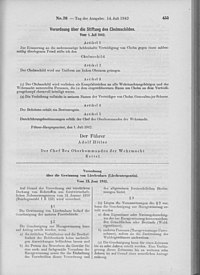Cholm shield

The Cholmschild was a sleeve shield of the Wehrmacht . It was awarded to German soldiers who had taken part in the defense of the Soviet city of Cholm , which was surrounded by the Red Army in 1942 .
Background to the creation of this award
In January 1942 the Soviet forces launched a general counter-offensive. In the course of the operations, the German-occupied city of Cholm was attacked on January 18, 1942. When this was cut off on January 21, a siege of the occupation began, which lasted until May 5, 1942 (see Battle of Cholm ). At that time, there were only quickly contracted security groups (including police and air force personnel) in the place. Under the command of Major General Theodor Scherer (1889–1951) and supplied from the air, the crew was able to hold out until they were relieved .
Design ideas and award practice

The first draft of the shield was based on a draft by Rottwachtmeister Schlimmer from the Reserve Police Battalion 65 during the siege . Supposedly, Major General Scherer presented this draft to Hitler on his first visit to the Fuehrer's headquarters . Hitler is supposed to have said (quote): Hmm, I can't do anything about that. To which Scherer quickly replied: Only approve, my guide! This was followed by a minor editing by Professor Richard Klein from Munich . The official foundation was dated July 1, 1942. On July 15 and August 24, the additions from the High Command of the Army , Air Force and Navy were added. Until January 30, 1944, applications for the award, which Major General Scherer made (or on behalf of), could be submitted. A total of around 5,500 awards were made.
Appearance
The upper part of the slightly arched shield consists of the stylistically emphasized imperial eagle , which has an iron cross with a central swastika in its claws. Below is the name of the boiler CHOLM and the year 1942, which stands for the time of the fighting, in capital letters . On the back there are three cotter pins (two next to each other in the middle, one below), a counter plate and a fabric base. The cholm shield had a size of 38 mm × 65 mm and was worn on the uniform on the left upper arm. In addition to the award, each recipient received an edition of the illustrated book “Kampfgruppe Scherer - 105 days included” (1943) by war correspondent Richard Muck.
Carrying method
The cholm shield was worn with the uniform on the left upper arm. It was also allowed to be worn on all party and state uniforms. A scaled-down form (16 mm needle) of the cholm shield on the left cloak of the skirt was allowed to be worn with bourgeois clothing. Soldiers with several sleeve shields ( Krimschild , Narvikschild ) and the Cholmschild mentioned here wore the first shield approx. 7 cm from the armhole seam of the left upper sleeve of the field blouse and the coat. The second shield was placed 0.5 cm below the cloth pad of the first shield. Holders of three shields wore the Cholm and Krim shield side by side , 0.5 cm below the cloth underlay of the Narvik shield, namely the Cholm in front of the Crimean shield.
Others
According to the law on titles, medals and decorations of July 26, 1957, wearing the award in the Federal Republic of Germany is only permitted without National Socialist emblems.
literature
- Kurt-G. Klietmann : Awards of the German Reich 1936–1945. A documentation of civil and military badges of merit and honor. 8th edition. Motorbuch, Stuttgart 1996, ISBN 3-87943-689-4 , p. 87 f.
Individual evidence
- ↑ Kurt-G. Klietmann: Awards of the German Reich 1936–1945. 11th edition. 2004, p. 87.
- ↑ How to wear several arm shields. In: Uniforms Market . Born 1943, issue 1/2.
